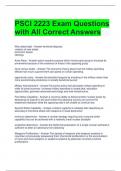Exam (elaborations)
PSCI 2223 Exam Questions with All Correct Answers
- Course
- Institution
PSCI 2223 Exam Questions with All Correct Answers Why states fight - Answer-territorial disputes creation of new states economic issues ideology Arms Race - Answer-action-reaction process which moves each group to increase its armaments because of the existence of those of the opposing gro...
[Show more]



